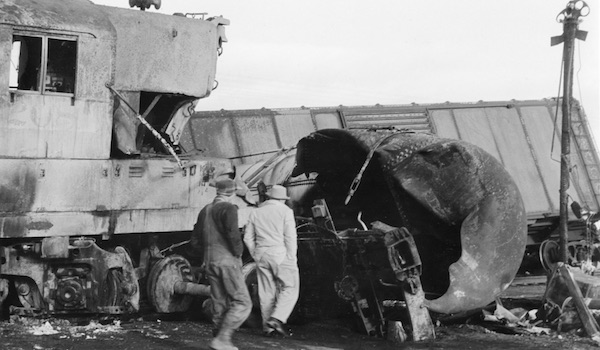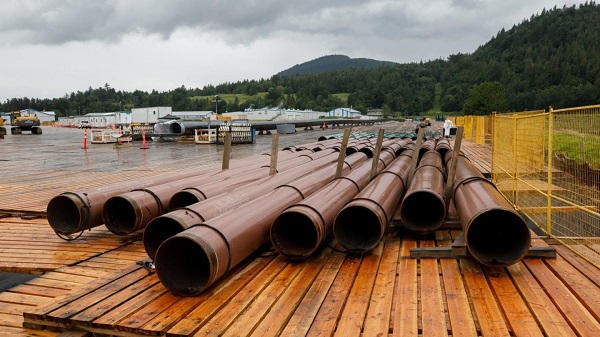Alberta
Painful History: The worst tragedy in the history of the Northern Alberta Railways

This article is submitted by members of the Alberta Railway Museum
CARBONDALE JUNCTION
On November 10, 1959, 13.6 miles North of Dunvegan Yards, the worst tragedy in the history of the Northern Alberta Railways (NAR) occurred. As a result, four people died and half a dozen men were released from their positions following a public inquest.
STATION HISTORY
The hamlet of Carbondale, North of Edmonton’s Dunvegan Yards, was at one time home to a small railway station on the Northern Alberta Railways (NAR) line. NAR was a CN-CP Rail joint venture that operated throughout Northern Alberta from 1929 to 1981. Carbondale is where the mainline split, allowing passengers and freight either West to Grande Prairie and Dawson Creek, or East to Fort McMurray.
The station was not only a stop en-route to several destinations along the line but, from 1956-1959 it was also the home of Station Agent Arthur “Art” Fraser, his wife Alice, and their youngest of three children, son Kelly (18 years) who were previous station agents in Smith, Alberta.

Courtesy of Shannyn Rus, 2020
SERIES OF TRAGIC EVENTS
On November 10, 1959, the weather was cool and a bit windy as the sun was peaking over the horizon. Carbondale Station was closed until 9am on weekdays and the Frasers were nowhere to be seen. NAR passenger train No.2 was southbound behind CN steam locomotive 5115, having left Grande Prairie the night before, destined for Edmonton. No.2 passed through Morinville at about 7:51 a.m., and was due at Carbondale at 8:00 a.m., on schedule, but was not scheduled to stop.
While the passenger train was headed south, NAR Train No.31, lead by NAR diesel locomotives 202 & 208 with 119 freight cars, left Edmonton behind schedule. In a rush to depart from the city at 7:20 a.m., crew members had improperly placed a tank car filled with gasoline directly behind the two engines, a violation of railway marshalling operating rules.
Upon reaching Carbondale at 7:51 a.m., No.31 moved to switch onto a sidetrack to allow the southbound passenger train to pass, but several cars detached from No.31 and were on the main track as the passenger train quickly approached. In a desperate attempt to notify the oncoming passenger train, the brakeman from the freight train ran ahead to deploy an explosive warning device called a torpedo on the track and wave a red flag signalling the steam train to stop. He did not get far, and the engineer of the passenger train did not see or hear the warning signals.
A precisely 8:00 am, the trains collided head on at a speed of 40 km/h (25 mph) resulting in a sound described by a witness as “atomic”. The impact ruptured the tank car, causing the rapid spread of gasoline over the station, a garage, and three vehicles. The gas immediately ignited. The bodies of the Fraser family were found outside of their home by a high-wire fence; it remains speculation as to whether they were attempting to flee the inferno or were blown from their home at the time of the explosion. The body of steam engine Fireman Albert Villeneuve was found in the buckled cab of the steam locomotive. An additional 19 people were injured in the accident.
Living just 18 metres (59 feet) from the station was retired coal miner William Dickinson. He told the Edmonton Journal in 1959 that the blast was “like an earthquake” and shook him awake. Seeing smoke and fire everywhere, he ran to the phone to report the collision, but the phone line was dead – the crash had taken out the phone and power lines, stopping his electric clock at precisely 8:00 am.
THE AFTERMATH
The fire obliterated the station, a garage, and three vehicles. Historic accounts show the station was destroyed except for its fireproof safe and brick chimney. An official investigation followed the collision. Conflicting testimony was given by the flagman from the freight train and the engineer from the passenger train. The flagman was required to go two kilometres (2,000 yards) beyond the stopped freight train to flag and alert the crew of the passenger train.
The flagman testified he went forward approximately 220 metres (240 yards); however, no footprints were found in the fresh snow beyond 23 metres (75 feet). The engineer of the passenger train stated that he did not see the red flag or hear the track torpedoes. The engineer also testified that he failed to see the freight train on the main track until he was about seven metres (23 feet) away, at which time he placed the brakes into emergency.
Following the investigation, the entire crew of No.31, the freight train, was dismissed by the NAR for violating the operating rules by having the train on the main track and not flagging down the passenger train. The engineer of the passenger train, No. 2, was also dismissed for not obeying the rule that the train be prepared to stop at the junction. The conductor of train No. 2 was severely reprimanded for not checking the signals at the junction and “for failure to exercise proper supervision over his train”.

Courtesy of Shannyn Rus, UPI Telephoto ARP-111101-November 10/59
THE BRICKS
62 years have passed since this tragic historic day and what remains buried of the Carbondale station has begun to reveal itself brick by brick. Carbondale resident Shannyn Rus and her family began finding these “ACP” stamped bricks in 2019. The chimney bricks were made by Alberta Clay Products (ACP) which existed from 1909 to 1962 in southern Alberta, near Redcliff.
The Rus family collected 20 full size, intact red bricks from the crash site and have donated them to rest at the Alberta Railway Museum as part of a collection of rail history not to be forgotten or buried again. You can find a short documentary on the Carbondale Station here.
Alberta
Schools should go back to basics to mitigate effects of AI

From the Fraser Institute
Odds are, you can’t tell whether this sentence was written by AI. Schools across Canada face the same problem. And happily, some are finding simple solutions.
Manitoba’s Division Scolaire Franco-Manitobaine recently issued new guidelines for teachers, to only assign optional homework and reading in grades Kindergarten to six, and limit homework in grades seven to 12. The reason? The proliferation of generative artificial intelligence (AI) chatbots such as ChatGPT make it very difficult for teachers, juggling a heavy workload, to discern genuine student work from AI-generated text. In fact, according to Division superintendent Alain Laberge, “Most of the [after-school assignment] submissions, we find, are coming from AI, to be quite honest.”
This problem isn’t limited to Manitoba, of course.
Two provincial doors down, in Alberta, new data analysis revealed that high school report card grades are rising while scores on provincewide assessments are not—particularly since 2022, the year ChatGPT was released. Report cards account for take-home work, while standardized tests are written in person, in the presence of teaching staff.
Specifically, from 2016 to 2019, the average standardized test score in Alberta across a range of subjects was 64 while the report card grade was 73.3—or 9.3 percentage points higher). From 2022 and 2024, the gap increased to 12.5 percentage points. (Data for 2020 and 2021 are unavailable due to COVID school closures.)
In lieu of take-home work, the Division Scolaire Franco-Manitobaine recommends nightly reading for students, which is a great idea. Having students read nightly doesn’t cost schools a dime but it’s strongly associated with improving academic outcomes.
According to a Programme for International Student Assessment (PISA) analysis of 174,000 student scores across 32 countries, the connection between daily reading and literacy was “moderately strong and meaningful,” and reading engagement affects reading achievement more than the socioeconomic status, gender or family structure of students.
All of this points to an undeniable shift in education—that is, teachers are losing a once-valuable tool (homework) and shifting more work back into the classroom. And while new technologies will continue to change the education landscape in heretofore unknown ways, one time-tested winning strategy is to go back to basics.
And some of “the basics” have slipped rapidly away. Some college students in elite universities arrive on campus never having read an entire book. Many university professors bemoan the newfound inability of students to write essays or deconstruct basic story components. Canada’s average PISA scores—a test of 15-year-olds in math, reading and science—have plummeted. In math, student test scores have dropped 35 points—the PISA equivalent of nearly two years of lost learning—in the last two decades. In reading, students have fallen about one year behind while science scores dropped moderately.
The decline in Canadian student achievement predates the widespread access of generative AI, but AI complicates the problem. Again, the solution needn’t be costly or complicated. There’s a reason why many tech CEOs famously send their children to screen-free schools. If technology is too tempting, in or outside of class, students should write with a pencil and paper. If ChatGPT is too hard to detect (and we know it is, because even AI often can’t accurately detect AI), in-class essays and assignments make sense.
And crucially, standardized tests provide the most reliable equitable measure of student progress, and if properly monitored, they’re AI-proof. Yet standardized testing is on the wane in Canada, thanks to long-standing attacks from teacher unions and other opponents, and despite broad support from parents. Now more than ever, parents and educators require reliable data to access the ability of students. Standardized testing varies widely among the provinces, but parents in every province should demand a strong standardized testing regime.
AI may be here to stay and it may play a large role in the future of education. But if schools deprive students of the ability to read books, structure clear sentences, correspond organically with other humans and complete their own work, they will do students no favours. The best way to ensure kids are “future ready”—to borrow a phrase oft-used to justify seesawing educational tech trends—is to school them in the basics.
Alberta
The case for expanding Canada’s energy exports

From the Canadian Energy Centre
For Canada, the path to a stronger economy — and stronger global influence — runs through energy.
That’s the view of David Detomasi, a professor at the Smith School of Business at Queen’s University.
Detomasi, author of Profits and Power: Navigating the Politics and Geopolitics of Oil, argues that there is a moral case for developing Canada’s energy, both for Canadians and the world.
CEC: What does being an energy superpower mean to you?
DD: It means Canada is strong enough to affect the system as a whole by its choices.
There is something really valuable about Canada’s — and Alberta’s — way of producing carbon energy that goes beyond just the monetary rewards.
CEC: You talk about the moral case for developing Canada’s energy. What do you mean?
DD: I think the default assumption in public rhetoric is that the environmental movement is the only voice speaking for the moral betterment of the world. That needs to be challenged.
That public rhetoric is that the act of cultivating a powerful, effective economic engine is somehow wrong or bad, and that efforts to create wealth are somehow morally tainted.
I think that’s dead wrong. Economic growth is morally good, and we should foster it.
Economic growth generates money, and you can’t do anything you want to do in social expenditures without that engine.
Economic growth is critical to doing all the other things we want to do as Canadians, like having a publicly funded health care system or providing transfer payments to less well-off provinces.
Over the last 10 years, many people in Canada came to equate moral leadership with getting off of oil and gas as quickly as possible. I think that is a mistake, and far too narrow.
Instead, I think moral leadership means you play that game, you play it well, and you do it in our interest, in the Canadian way.
We need a solid base of economic prosperity in this country first, and then we can help others.
CEC: Why is it important to expand Canada’s energy trade?
DD: Canada is, and has always been, a trading nation, because we’ve got a lot of geography and not that many people.
If we don’t trade what we have with the outside world, we aren’t going to be able to develop economically, because we don’t have the internal size and capacity.
Historically, most of that trade has been with the United States. Geography and history mean it will always be our primary trade partner.
But the United States clearly can be an unreliable partner. Free and open trade matters more to Canada than it does to the U.S. Indeed, a big chunk of the American people is skeptical of participating in a global trading system.
As the United States perhaps withdraws from the international trading and investment system, there’s room for Canada to reinforce it in places where we can use our resource advantages to build new, stronger relationships.
One of these is Europe, which still imports a lot of gas. We can also build positive relationships with the enormous emerging markets of China and India, both of whom want and will need enormous supplies of energy for many decades.
I would like to be able to offer partners the alternative option of buying Canadian energy so that they are less reliant on, say, Iranian or Russian energy.
Canada can also maybe eventually help the two billion people in the world currently without energy access.
CEC: What benefits could Canadians gain by becoming an energy superpower?
DD: The first and primary responsibility of our federal government is to look after Canada. At the end of the day, the goal is to improve Canada’s welfare and enhance its sovereignty.
More carbon energy development helps Canada. We have massive debt, an investment crisis and productivity problems that we’ve been talking about forever. Economic and job growth are weak.
Solving these will require profitable and productive industries. We don’t have so many economic strengths in this country that we can voluntarily ignore or constrain one of our biggest industries.
The economic benefits pay for things that make you stronger as a country.
They make you more resilient on the social welfare front and make increasing defence expenditures, which we sorely need, more affordable. It allows us to manage the debt that we’re running up, and supports deals for Canada’s Indigenous peoples.
CEC: Are there specific projects that you advocate for to make Canada an energy superpower?
DD: Canada’s energy needs egress, and getting it out to places other than the United States. That means more transport and port facilities to Canada’s coasts.
We also need domestic energy transport networks. People don’t know this, but a big chunk of Ontario’s oil supply runs through Michigan, posing a latent security risk to Ontario’s energy security.
We need to change the perception that pipelines are evil. There’s a spiderweb of them across the globe, and more are being built.
Building pipelines here, with Canadian technology and know-how, builds our competitiveness and enhances our sovereignty.
Economic growth enhances sovereignty and provides the resources to do other things. We should applaud and encourage it, and the carbon energy sector can lead the way.
-

 COVID-192 days ago
COVID-192 days agoTrump DOJ seeks to quash Pfizer whistleblower’s lawsuit over COVID shots
-

 Alberta2 days ago
Alberta2 days agoAlberta introducing three “all-season resort areas” to provide more summer activities in Alberta’s mountain parks
-

 Agriculture2 days ago
Agriculture2 days agoGrowing Alberta’s fresh food future
-

 International2 days ago
International2 days agoTrump admin wants to help Canadian woman rethink euthanasia, Glenn Beck says
-

 Alberta2 days ago
Alberta2 days agoThe case for expanding Canada’s energy exports
-

 Censorship Industrial Complex1 day ago
Censorship Industrial Complex1 day agoOttawa’s New Hate Law Goes Too Far
-

 Business1 day ago
Business1 day agoFuelled by federalism—America’s economically freest states come out on top
-

 Automotive1 day ago
Automotive1 day agoPoliticians should be honest about environmental pros and cons of electric vehicles







